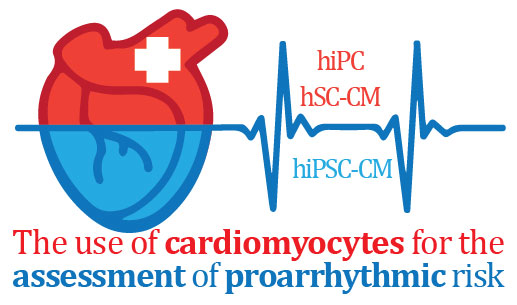
Attrition of novel drug candidates due to cardiovascular liabilities (including proarrhythmic risk due to delayed ventricular repolarization and Torsades-de-Pointes arrhythmia) remains a hurdle for drug discovery efforts, a hurdle which may be mitigated by the use of human induced pluripotent stem-cell derived (hiPSC)-cardiomyocytes.
 At present, there generally are two approaches used to indirectly assess proarrhythmic risk: an in vitro human Ether-a-go-go-Related Gene (hERG) assay and an in vivo QT interval assessment. The in vitro hERG assay only examines drug block of the repolarizing IKr/hERG potassium current, one of multiple cardiac currents that a drug may block to affect proarrhythmic risk. This limited in vitro assessment provides for high sensitivity, but low specificity, which may lead to drug candidates being screened out of drug pipelines inappropriately. Nonclinical in vivo assessment of QT interval in cardiovascular safety pharmacology studies has limited predictive value as well, often necessitating a “Thorough QT” clinical study later in development. The Thorough QT clinical assessment also has its limitations, as those studies are done in humans and typically require large numbers of patients. The cost of these large QT interval clinical trials is not trivial either, while the data collected about QT interval is again only a small piece of the story when investigating proarrhythmic risk of a drug.
At present, there generally are two approaches used to indirectly assess proarrhythmic risk: an in vitro human Ether-a-go-go-Related Gene (hERG) assay and an in vivo QT interval assessment. The in vitro hERG assay only examines drug block of the repolarizing IKr/hERG potassium current, one of multiple cardiac currents that a drug may block to affect proarrhythmic risk. This limited in vitro assessment provides for high sensitivity, but low specificity, which may lead to drug candidates being screened out of drug pipelines inappropriately. Nonclinical in vivo assessment of QT interval in cardiovascular safety pharmacology studies has limited predictive value as well, often necessitating a “Thorough QT” clinical study later in development. The Thorough QT clinical assessment also has its limitations, as those studies are done in humans and typically require large numbers of patients. The cost of these large QT interval clinical trials is not trivial either, while the data collected about QT interval is again only a small piece of the story when investigating proarrhythmic risk of a drug.
The newly proposed Comprehensive in Vitro Proarrhythmia Assay (CiPA) offers a different strategy for defining proarrhythmic risk based upon a clear understanding of torsadogenic mechanisms beyond simply blocking hERG/IKr current. With CiPA, human iPSC-cardiomyocytes are employed to assess drug effects on the cardiac action potential to confirm the outcome of in silico modeling efforts, relying on hiPSC-cardiomyocytes to provide the integrated drug response from multiple native human currents in a human-derived cellular preparation. However, according to Norman Stockbridge, MD, PhD, US Food and Drug Administration (US FDA) Division of Cardiovascular and Renal Products, these cardiomyocytes don’t exactly mirror the density and proportions of ion channels found in normal human adult cardiomyocytes. Therefore, there is a need to further characterize the assay system and refine how to culture, use, and interpret data from these hiPSC-cardiomyocytes.
Despite their limitations, hiPSC-cardiomyocytes produce action potentials, and one can see drug effects when treating the cells. Gary Gintant, PhD, Abbvie, is optimistic that further advancements in the use of hiPSC-cardiomyocytes will significantly reduce the need for cardiovascular safety testing in animals, but there remains much to be learned about hiPSC-cardiomyocytes to understand the proper conditions for their use in preclinical safety testing.
 To aid in the development of this emergent technology, “The Use of Cardiomyocytes for the Assessment of Proarrhythmic Risk” Contemporary Concepts in Toxicology (CCT) meeting will be held October 25‒26, 2016, in Arlington, Virginia. The CCT Chair Douglas Keller, PhD, DABT, Sanofi, says that the workshop has three main focal points:
To aid in the development of this emergent technology, “The Use of Cardiomyocytes for the Assessment of Proarrhythmic Risk” Contemporary Concepts in Toxicology (CCT) meeting will be held October 25‒26, 2016, in Arlington, Virginia. The CCT Chair Douglas Keller, PhD, DABT, Sanofi, says that the workshop has three main focal points:
- Understanding the phenotype and limitations of working with the hiPSC-cardiomyocytes.
- Learning how researchers are using these cells currently and facilitating information sharing among users.
- Investigating advanced uses, such as what hiPSC-cardiomyocytes potentially can be used for in the future.
Through workshops such as this, the CCT initiative aims to promote development of cutting-edge tools and approaches to toxicology and risk/safety assessment to enhance the professional and scientific development of toxicologists and other scientists. Stay tuned for more opportunities to broaden your horizons!